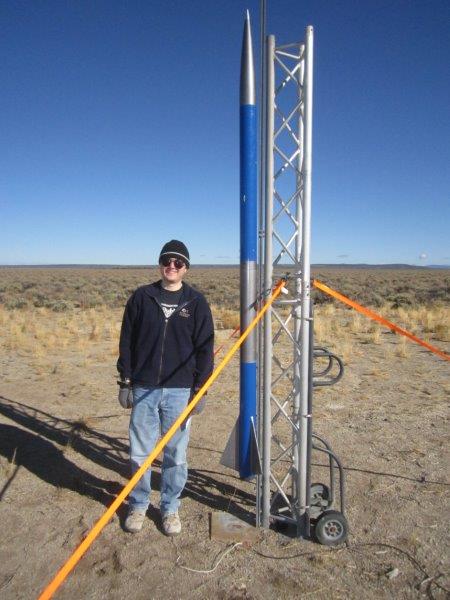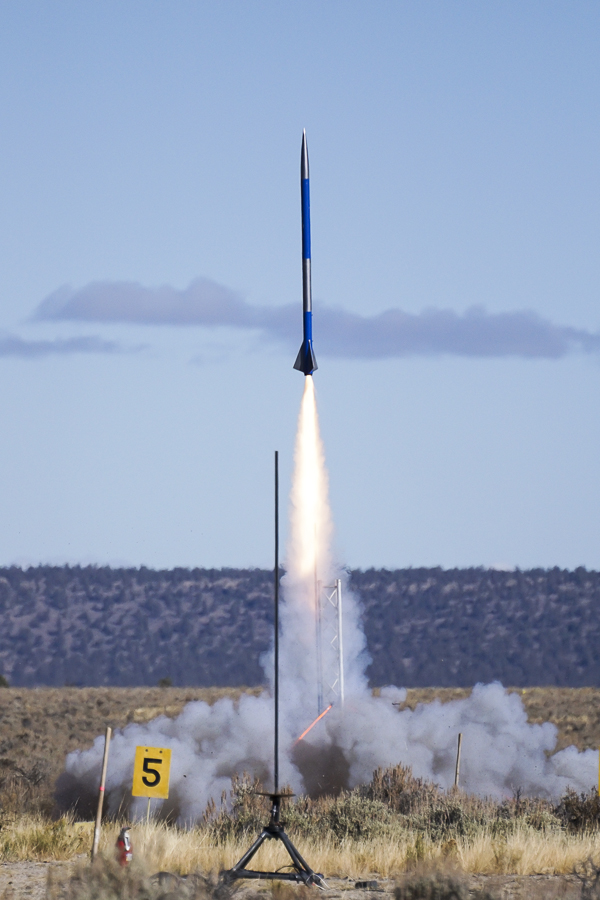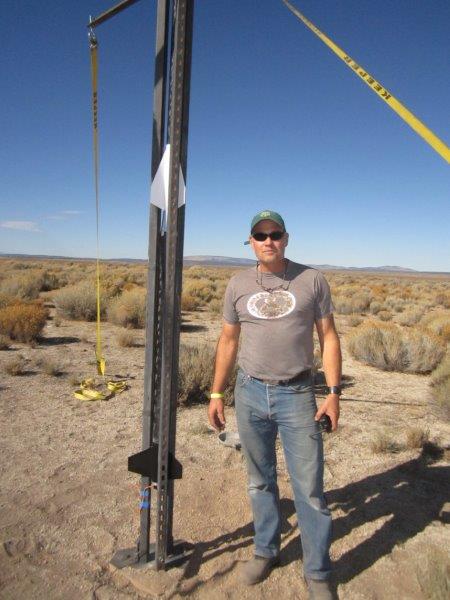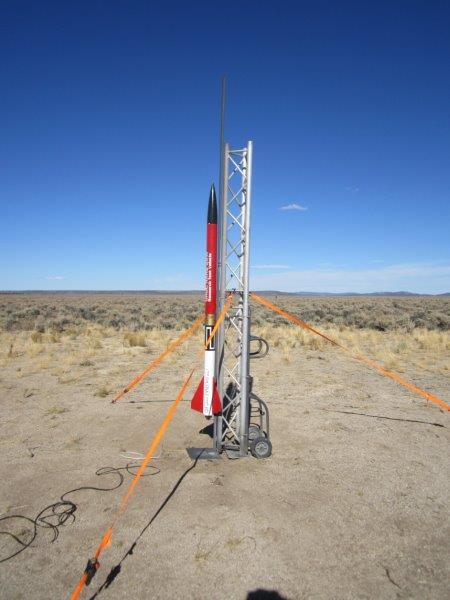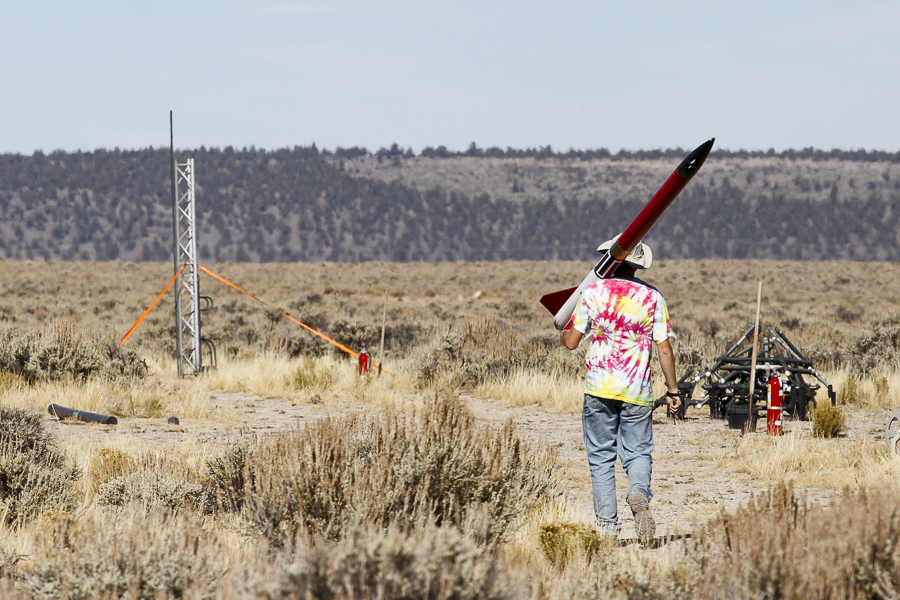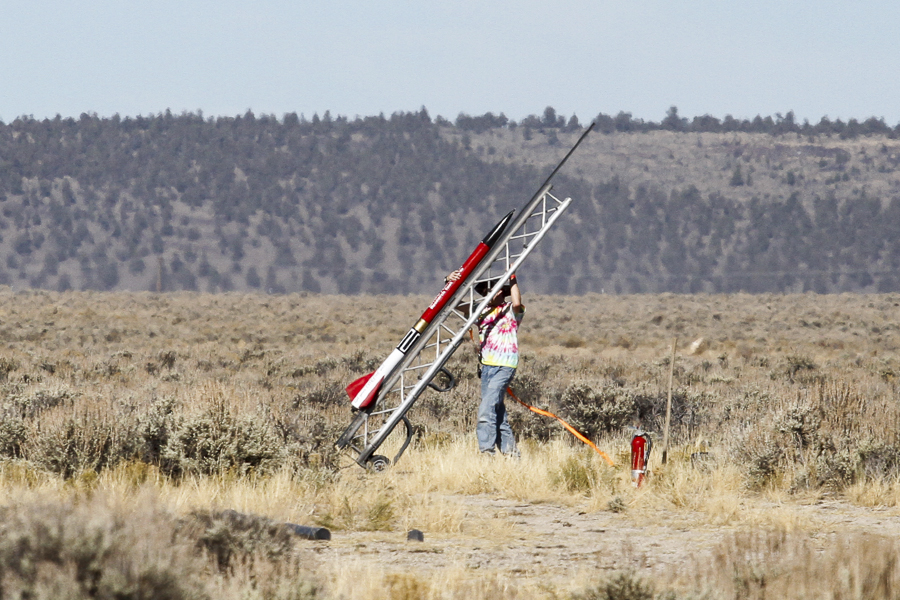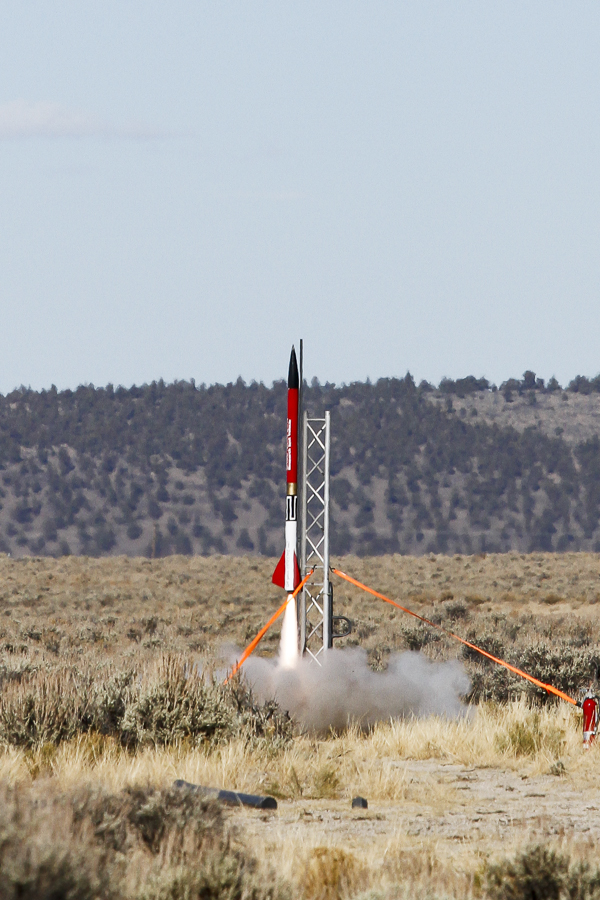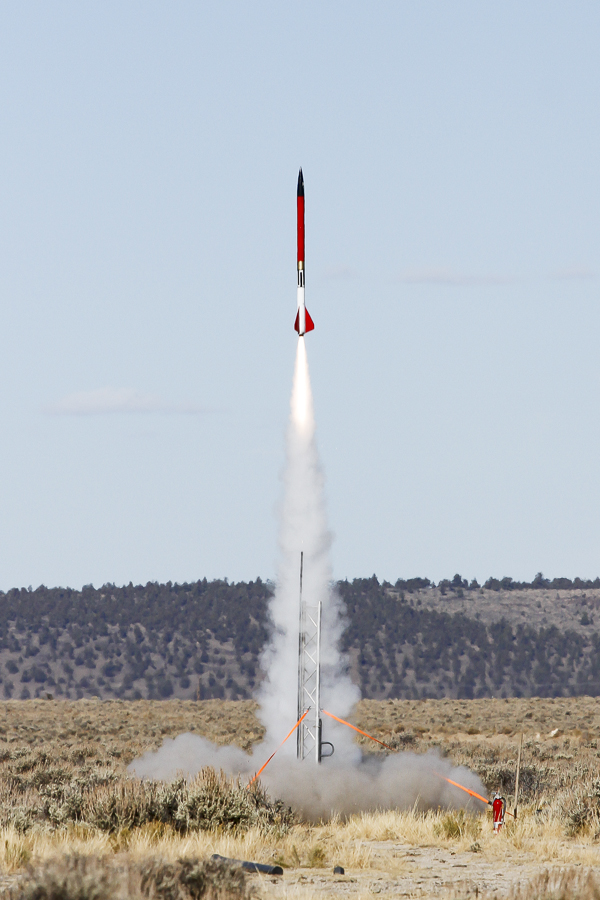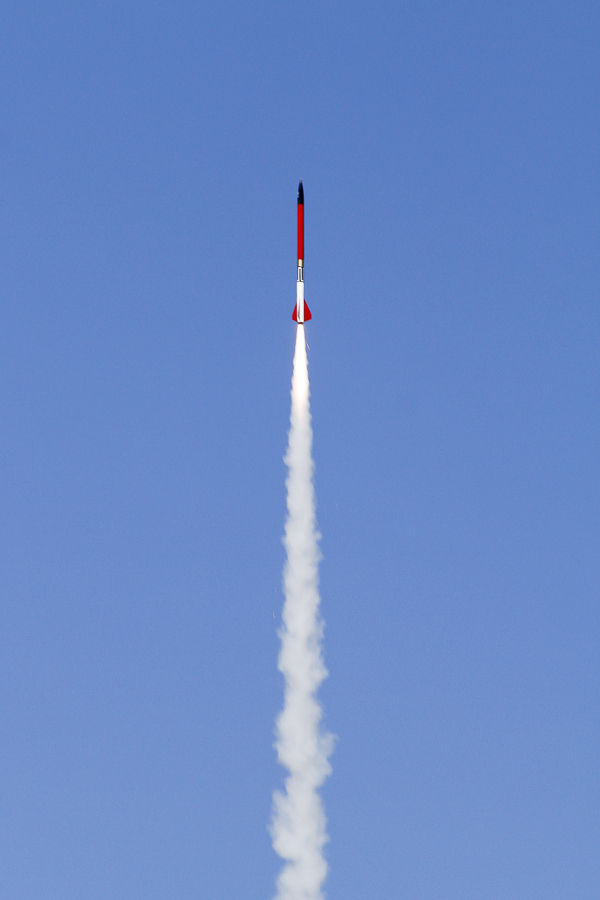Rocketober 2014 - October 17-19, 2014 (Brothers, OR)
OROC’s last high power launch of the year was certainly not one to be forgotten. I think we had some of the best October weather I’ve seen in a while!
I loaded up the truck and left Portland at about 5:30 on Friday morning, which was early. After picking up some groceries and ice I headed down to Wilsonville to pick up Peter DeKluyver, who I was giving a ride out to Brothers. We loaded up his stuff, stopped for breakfast, and headed over the pass. Fairly uneventful drive, with a stop in Bend to pick up a motor reload for Neil Anderson. We arrived in Brothers around 11:00 and got situated. I had 2 rockets fully prepped that afternoon, but nothing that would stay below the cloud deck so flying was not an option that day. After lunch we were hit by a brief but persistent rain shower that lasted maybe half an hour before blowing by. Fortunately, we were all convinced that this would be the worst weather day of the weekend.
Given the conditions there were only a few smaller rockets flown that day, and for everyone else it was mostly a “hanging out in the sage” kind of day. After dinner that evening was some great company around the fire, with lots more people rolling in throughout the night.
Saturday morning brought the clear skies and low winds that everyone was hoping for. After breakfast it was time for my big flight of the weekend – an M840 moonburner in Code Blue (CTI 75mm 6-grain). This flight was intended to go at BALLS, but the clouds and launch organizers there prevented it. After having to look at the fully assembled and prepped rocket sitting in my shop for the last month, needless to say I was eager to fly it. This was my biggest motor to date and also Code Blue’s biggest push so far. I borrowed Gary Lech’s 70cm Beeline GPS for this flight, put some shear pins in the nosecone, and 10 minutes later the rocket was on the tower, ready for action.
(Photo credit to David Birch.)
(Photo credit to Gary Goncher.)
Tim Ryerse did the honors and the motor took its sweet time to light up. But when it did, Code Blue roared off the pad on a big white flame and just kept going up for what felt like an eternity.
Gary was calling out the altitude clear up to 25K MSL. This was exciting to hear as it meant I had hit about 21K AGL, a personal altitude record as well as 2,000’ higher than the simulation. Shortly after apogee reported some bad news – it was coming in very fast. As Gary keeps calling out the altitude it became clear that we were coming in ballistic, then seconds later we hear a “RRRRRSHHHH” in the distance...the fairly telling sound of a main chute being deployed at several hundred miles an hour. This was my “Oh s***” moment as we were all pretty certain that the rocket was down now. Entering in the last set of coordinates gave me a waypoint that was about a mile southeast of the flightline…in the direction we heard the impact sound.
We hopped in the truck and drove for a bit, but we were still a little under a mile from the waypoint. After hiking around in the sage for a while we got lock again, which was good since it meant that the GPS was still OK. Gary spotted my main chute and upon recovery we discovered it was ONLY a main chute, not connected to anything. Walking a little farther we found the nosecone (unharmed with the GPS inside) and some harness, then walking further still we found this...
Damn. Our theories were exactly right. No drogue at apogee, but the main deployed. After digging what remained of the fin section out, I came across some very crunched sections of fiberglass airframe, as well as lots of little pieces of altimeters. My estimate is that there is still about 36” worth of 4” fiberglass buried underground – I’ve noted the GPS coordinates should I wish to return with a shovel sometime, but I have I feeling it will remain there for the unforgiving rocket gods... Upon initial examination, it would appear as though both drogue charges fired, but didn’t cut the shear pins for some reason.
I hauled the remains back to camp and got some lunch going. Many thanks again to Gary Lech for loaning me his 70cm Beeline for this flight, and for all the recovery help. After my LCO shift that afternoon, I knew I had to end the day on a high note. I prepped my PML Miranda on an I327DM. This was my first (and only) sparky motor flight of the season, and it was to be a part of the second annual “Rocketober Sparky Dragrace” between me, Chuck Fauser, Ryan Fauser, and Rob Appleton. Rob had some problems with his truck earlier that week so he couldn’t make it to the launch, meaning we were down one contestant. Chuck and Ryan were both flying Loki Spitfire reloads, and I was flying Aerotech Dark Matter. This was also to be my Raven altimeter test flight which needless to say I was a bit nervous for. I did put black powder in the forward closure for motor backup (14 second delay), which I don’t normally do. But considering I was unsure about this altimeter plus the misfortune of my last flight, I opted to play it safe.
With 3 rockets racked up, we were ready to go. My rocket took off first, likely because I used my own igniter and I almost reached apogee before Ryan’s rocket left the pad. For the second year in a row, Chuck’s rocket didn’t go. Sorry Chuck, maybe next year that curse will be broken... I saw both my apogee charges fire (Raven plus motor backup) and the rocket sections tumbled drogueless until I hit 500’, at which point my main came right out on time. Recovery was an easy walk just past the away cell – I was trying to think of when I last recovered a rocket that close to the flight line. While I only used channels 1 and 2 of the Raven, the altimeter worked perfectly and I am now planning on how to implement them in other rockets.
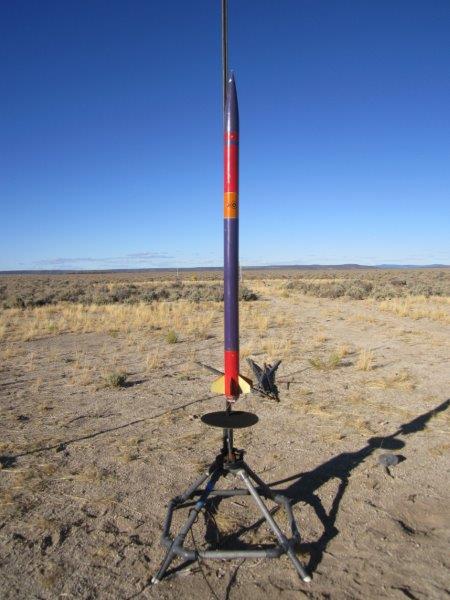
This was a great way to end my flying day, so I cleaned a few motors and helped Peter fly a J800T in a 3” Oregon Ducks-themed rocket to about 5,500’. (A lot higher than we all thought it would go.) Later that evening I was invited over to Neil Anderson’s camp for a fabulous Alaskan King Crab dinner – thanks again Neil and Steve! Saturday night was another great time around the campfire.
On Sunday there were 3 high-altitude flights scheduled, 2 of which I helped support. After Neil’s second 2-stage flight of the weekend, a group of us headed up to the hill to help wrestle Rick Clapp’s Cherokee-M onto Neil’s big pad. Rick recently had this rocket re-painted after its previous misfortune a number of years ago, and this was its first flight since then. When Steve pushed the button, the N3300R really got it moving! Add in a perfect recovery and it was an excellent launch, great job Rick.
Headed back to camp and had a “Sunday brunch” of sorts before checking with Rob Lamb on the status of his 2-stage flight. He had been heads-down all weekend long (not to mention the week before) getting ready to fly a CTI M2250 C-Star to a CTI K300 Classic longburn. I got my Sunday flight prepped which was to be a K1103X in my NXRS RTV. Rob was ready to go around 1:00 that afternoon so we headed up to the hill to get the thing put together. This was quite a process that involved fiddling with the interstage coupler, arming about 6 different Perfectflite altimeters, and adding shear tape in various places. BIG thank you to Alan Hammond for extending the high waiver for us (we didn’t even have to ask) as that allowed us to work at a much more relaxed pace as we did the final preparations. Before we retreated I made Rob pose for a quick photo...
Tim Ryerse gave us our 10-count and Rob had me do the honors. The M2250 lit up almost instantly and that rocket was out of there! It separated perfectly at which point the K300 came to life, right on cue. Unfortunately it was just after that moment when we spotted a problem – at first we thought the sustainer lost a fin, but after recovery it was clear that the sustainer motor may have blown the forward closure shortly after ignition. Either way, great attempt Rob, here’s hoping that “2-stage curse” will be broken next season.
After coiling up my launch system I headed back to camp to get my last rocket up. Thanks to those who made sure the house launch controller was kept intact during range tear-down so I could use it for my flight!
After my first igniter blew somehow, the K1103X boosted my rocket sharply to about 7,500’. This was a really cool motor that has a thrust profile very similar to that of the K1100T, but with a white flame/smoke so it looks more like a fast White Lightning. I flew this rocket drogueless as well, which proved to be very wise as it looked like it drifted about clear to the highway before the main deployed. It my haste to get this flight up, I neglected to put GPS in it. This turned out to be a recipe for a slightly longer evening than I had planned for. But with a good visual bearing on recovery, I figured I was set for recovery. Since it appeared to have landed nearby the highway, I opted to pack up camp and leave the launch site, THEN hunt for my rocket. After saying my goodbyes I drove out the main entry road until I reached the “right turn.” Given the bearing and my approximation on landing, I was real sure that I was close by. An hour of hiking around in the sage turned up nothing, at which point I headed back to the truck for a break and to replenish my water supply. 20 more minutes of searching along a different line and I stumbled right upon it! Everything looked perfect as I walked back to the truck with rocket in hand. The sun was setting just as I pulled onto the highway and that was it for my 2014 season.
Gary Goncher got a very nice photo sequence of the flight:
Following a dinner and fuel stop in Prineville was a very easy drive back home. I was still pretty disappointed about crashing my big rocket, but getting in 2 perfectly successful flights after that was a great turnaround. Thanks everyone for a great season, and happy building! :)

